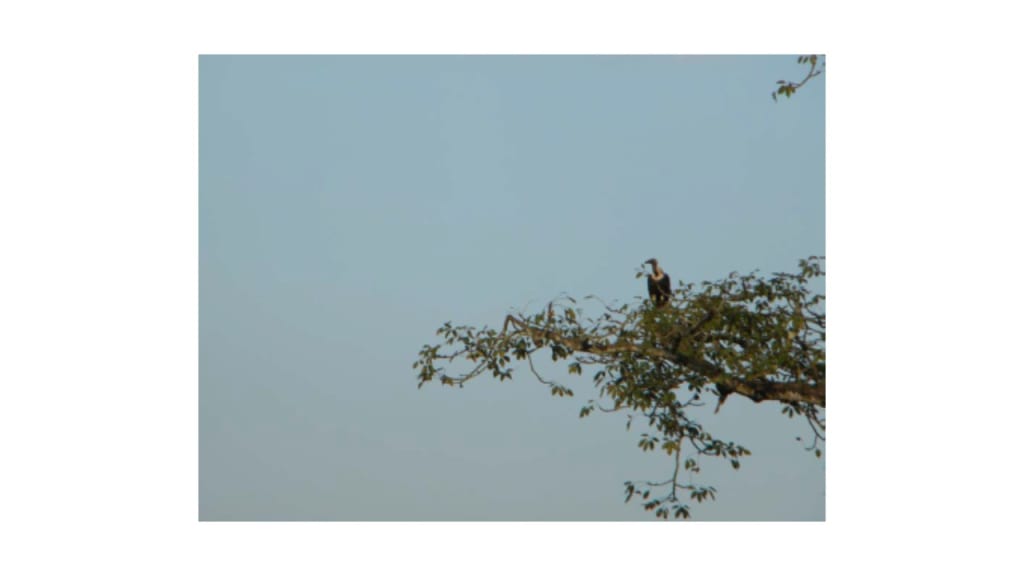Save the vultures. Respect the cows.
The decline of the vulture in the Indian subcontinent and the inspiring recovery efforts to save them.

Vultures
When people think of a vulture, they often think of ugly, scary birds, associated with death. Birds that are found lingering near dying animals. In popular culture, they are often see as a bad omen. However, within the country of Nepal and the greater Indian subcontinent, vultures are significant in many ways – environmentally, economically and spiritually.
Vultures are large predatory birds and are obligate scavengers that only feed on the carcasses of dead vertebrates. They are of the genus “Gyps” and are found in every continent on Earth, except Australia and Antarctica.
Of the nine species of Acciptridae vultures found in the country of Nepal and the Indian subcontinent, there are three Gyps species of vulture whose considerably diminished populations have been in danger of facing extinction and are classified as being ‘Critically Endangered’.
Cows
In Hinduism, a cow is considered a sacred symbol of life and is associated with Aditi, the mother of all gods. The slaughter of a milk-producing cow is prohibited and is a major crime in the Hindu-dominated county of Nepal, with a maximum punishment of 12 years jail. The killing of a cow for meat is deemed greedy, when it is already a source of goodness, providing five products to other creatures - milk, curd, butter, urine and dung. Due to the illegal nature of killing a cow in Nepal, domesticated ungulates would often die of old age and would often develop arthritis in their old age.
The carcasses of the predominantly domesticated cows are typically left where they fall or disposed of in allocated and regulated ‘carcass dumps.’ There is an entire industry around the remains of these cows, which often involves the vulture in the process. The dead cow’s hide is removed for use in the leather industry leaving the vultures to remove the soft tissue from the carcass. A flock of vultures can clean a carcass within a few hours leaving just the bones. The bones are dried in the sun, and then used in fertilisers, gelatin and glue. As a result, in countries such as India and Nepal, they play a significant role through disposing of animal and human remains.
Cows and Vultures – The Circle of Life
In the Indian subcontinent, the domesticated cow and the vulture both play important parts of their local ecosystems and processes.
Vulture populations thrive where there are large amounts of food available and provide environmental, health and other benefits to communities. A diminished vulture population results in a less effective system of cow carcass disposal.
For example, a decrease in vulture populations results in a higher food availability on the street. The higher food availability leads to a dramatic increase in the number of stray dogs. The increase in the number of stray dogs leads to an increased potential to spread rabies.
Additionally, the industries that currently rely on vultures to clean the bones could also be threatened by the decline of vultures. There is also the potential risk of water-borne disease near places of habitation as well as waste disposal problems with land and water contamination causing loss of income for farmers.
The Investigation into the Decline of the Vulture Population
The Gyps vultures, which inhabit the Indian subcontinent, have decreased in numbers dramatically during the 1990s. By 2007, three species of Gyps vultures had their numbers regress by 97% since 1992. In 2012, It was described as “the fastest decline of any bird species ever reported anywhere in the world." Surveys were undertaken to determine the cause of this decline, concluding that during this time, there was a dramatic increase in adult mortality rates.
Autopsies conducted on dead vultures showed a high incidence of fatal kidney damage ('visceral gout') consistent with concentrations of diclofenac in the vulture’s systems. Diclofenac has been used extensively to reduce the symptoms of arthritic pain and swelling in livestock and became common practice in countries such as India, Nepal and Pakistan during the 2000s.
This medication was determined as the main cause of this decline. It has been proven in studies that when vultures feed on the remains of ungulates treated with diclofenac that the vultures die within days with residual traces of the medication in their system. Vultures exposed to diclofenac suffer kidney failure.
After studies and evidence concluded that diclofenac was the main cause of the vulture’s decline, a movement in the Indian subcontinent began to ban the use of diclofenac.
Saving the vultures - Action 1: Banning the use of diclofenac for the treatment of arthritis in elderly cows
In 2004, efforts began to try and stop the use of diclofenac in veterinary practices.
The licence to use diclofenac in India was withdrawn by the Drug Controller General of India in 2006. The drug was also banned in Nepal and Pakistan in 2006, and in Bangladesh in 2010. The sole reason was to the lethal effect the medication had on vultures.
The importance of vultures, as noted above, was recognised and the countries understood that the extinction of vultures would lead to problems such as the increase in rotting domesticated ungulate carcasses, an increase in feral dogs and an increase in potential health risks.
Although the prohibition of veterinary use of diclofenac in practices occurred in Nepal and India in 2006, the drop in vulture populations should have stopped instantaneously, however, it didn’t.
Two surveys were undertaken in India in 2008 that involved taking liver samples from dead domesticated cows. There were still substantial numbers of samples with diclofenac found in their system. The frequency of positive results for diclofenac as well as the amount of diclofenac found in their systems, however, had declined significantly.
There seemed to be a problem with immediate eradication of diclofenac as there was resistance to changing practices that had previously involved the use of substantial amounts of the medication. It had been used in the Indian subcontinent since ~ 1990. It was estimated that roughly 12 million doses were used on 5 million animals across India, hence making it very difficult to eliminate from the system. There had been some decline in the use of diclofenac with the ban, however, simply banning the drug would not be enough to save the vultures.
Saving the vultures - Action 2: The trials for an alternative drug
A study by Naidoo et. al., 2007 was undertaken on the pathophysiology of the diclofenac. The aim of the study was to “validate the fowl as a model for the study of diclofenac-‐induced intoxication in vultures to allow for future evaluations of the mechanism of toxicity.” The cause of death was found to be due to a decrease in uric acid excretion.
By studying the way diclofenac became toxic in a vulture’s system, studies, such as Naidoo & Swan, 2009, compared this physiology to the effect of other drugs (such as Meloxicam) and used these results to find a new, alternative, safer drug.
Due to the nephrotoxicity that cause vultures to die when diclofenac is ingested, a new drug was trialed and introduced successfully in its place. This drug is called meloxicam and is effective in livestock for the same symptoms as diclofenac (such as pain, inflammation) whilst not being toxic to vultures who feed on the livestock afterwards. A study done by Ng, et al., 2008 compares the toxicity of the two drugs and concludes that ‘that diclofenac was more toxic than meloxicam to two types of cells and leads to mitochondrial cell death (which is what makes diclofenac fatal to vultures).’
Saving the vultures - Action 3: The active replacement with the new, (safer) alternative drug
After the various studies were conducted and diclofenac was banned, veterinary practices were encouraged to use the new alternative drug, Meloxicam. Many strategies have been discussed to try and further convert people to using Meloxicam and deter people from using Diclofenac.
Local conservation groups, such as Himalayan Nature, continue to advocate the use of meloxicam as a substitute to diclofenac. Dr Hem Sgara Baral, Chief Technical Advisor, in 2014 noted that order to replace the diclofenac with meloxicam; they presented the case to several international NGOs who donated money to the cause. NGOs, such as Himalayan Nature, then travelled around the Indian subcontinent in efforts to take away diclofenac stocks and replace them with meloxicam.
Saving the vultures - Action 4: Continued community awareness, captive breeding and vulture restaurants
Aside from banning diclofenac and introducing a new alternative drug, Meloxicam to the veterinary community, there have been several schemes incorporated to assist in recovering the vulture population including vulture restaurants, captive breeding and community education.
The concept of a vulture restaurant was introduced into vulture countries such as Nepal in order to try and recover the endangered vulture species populations. The idea of the vulture restaurant is that it provides ‘safe diclofenac-free food sources in close proximity to breeding sites.’ The restaurants buy old and unwanted cattle from farmers who are content to sell or give them away. These domesticated cattle (mainly cows) are then given vulture safe medication if needed until they die (similar to a cow nursing home), after which they are placed out in a specific area for the vultures to safely feed on. Vulture restaurants have now been successfully introduced in many regions of the Indian subcontinent.
The first International Vulture Awareness Day was conducted on the 5th September 2009 in Nepal, and 8,200 people attended from different backgrounds.
This work is aimed at encouraging positive attitudes towards vultures and their conservation through ongoing public education in schools, universities, nearby communities and to relevant professionals on the vulture, using safe NSAID meloxicam and removing diclofenac.
The efforts to recover vulture populations on the Indian subcontinent have been impressive, especially, the way the authorities and governments in the region and the international conservation community recognise the importance of vultures (despite their usual stereotype) in their ecosystems and have worked together to manage the decline in their population. The detective work to identify the problems caused by diclofenac and to find a safer alternative, then to make the conversion into law, and then enforce those laws were inspirational.
The noticeable recovery of vulture population after the diclofenac ban validates how strong investigation, studies and ample activism can go a long way to warranting successful conservation and bring hope in saving the population of an important animal - the vulture.
It is not too late to save the vultures.





Comments
There are no comments for this story
Be the first to respond and start the conversation.